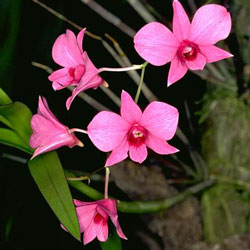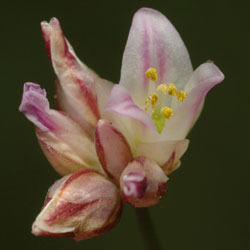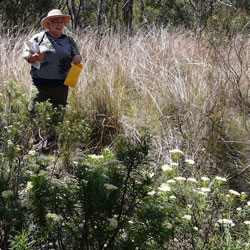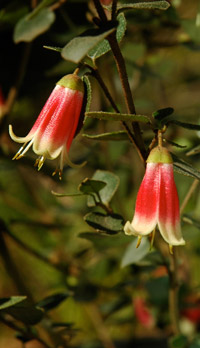Spring 2012 - Issue 3
Winter 2012 - Issue 2
Autumn 2012 - Issue 1
News 2011
News 2010
Huge Centenary summer at the Gardens
Getting ready to kick off Canberra’s centenary year in style, the Australian National Botanic Gardens have announced an exciting program of summer events.
The Gardens and the Friends of the Gardens will start the centenary year with the month-long 2013 Summer Sounds Centenary Concert Series, featuring some of the best band and dance talent in the nation’s capital.
“We’ve got a terrific entertainment line-up this January with everything from jazz, swing, big band, Latin American, country, rockabilly, popular and even hip hop - all sure to get everyone on their feet and dancing,” the Gardens’ Executive Director, Dr Judy West said.
“We’re extending the concert times so people can enjoy the music, dancing and our beautiful garden surrounds even longer. The concerts will start at 5.30 pm and conclude at 7.30 pm every Saturday and Sunday night throughout January.”
Following Summer Sounds, Australian award winning band The Whitlams will perform at the Gardens on 2 February as part of Optus Flix in the Stix. Visitors will enjoy an intimate evening of quality short films and live music on the relaxing Eucalypt Lawn.
“We love the outdoor cinema concept so much, we’re hosting a special centenary Sunset Cinema, a six –week outdoor film program beginning on Thursday 7 February,“ Judy said.
“ Each Thursday, Friday and Saturday evening until16 March, visitors will be able to enjoy the latest releases, classic and arthouse films while relaxing with a picnic, a pre-ordered evening meal – or just like a real cinema - hot buttery popcorn available on site.
“We’ll continue to bring the Rainforest Gully to life at night with our popular afterDARK series. On Friday 4 January and Friday 1 February, our special adults only summer theme is Delicious! afterDARK – a sensual feast of summer night Gardens tours, live string music and gourmet tasting of local food and wine.
“And this centenary summer, we’ll be catering for all ages and tastes with Bush Magic Storytime, the Snakes Alive! reptile exhibition and Friends and Family in the Gardens – A Capital Experience photographic exhibition.”
For further information on the Gardens’ summer events visit: www.anbg.gov.au/gardens/whatson/index.html
Plant Conservation in Australia - Achievements and Future Directions
The Australian Network for Plant Conservation (ANPC) is turning 21 and to mark the special occasion, ANPC is hosting its 9th National Conference entitled Plant Conservation in Australia - Achievements and Future Directions.
Held in partnership with the Australian National Botanic Gardens, the ANPC National Conference will bring together people involved in plant conservation from around the country and will provide a significant networking opportunity for participants.
“This is a very exciting time for us. Not only are we celebrating our 21st birthday but we’re bringing together many people with a passion, persistence and vision for plant conservation in Australia to discuss, collaborate and share ideas for the future,” ANPC President David Coates said.
“We will be reviewing and highlighting achievements over the last two decades, highlighting current issues and identifying plant conservation directions in Australia for the coming decades. I think the participants will get a lot out of this conference.”
Executive Director of the Australian National Botanic Gardens Dr Judy West described the partnership with the ANPC as invaluable.
"The ANPC does stimulating work promoting conservation of our native plants and plays an extremely effective role in capacity building, developing expertise in conservation practices,” Judy West said.
“One of the network’s key strengths is the ability to link people with an active interest in plant conservation throughout Australia – it promises to be a very rewarding conference.”
The 9th ANPC National Conference will be held from Monday 29 October to Friday 2 November at the Canberra Rex hotel and will be opened with a special welcome reception at the Australian National Botanic Gardens. Registration closes on 12 October.
For further information about the conference, visit the ANPC website www.anpc.asn.au
The Australian Network for Plant Conservation is a non-profit organisation whose mission is to promote and improve plant conservation.
Explore 200 years of Australia's natural history - at the click of a mouse 
Want to know more about Australia’s fascinating plants and animals? Find out today thanks to new and updated versions of the Australia’s Virtual Herbarium and the Online Zoological Collections of Australian Museums.
The two websites let everyone from enthusiastic amateurs to research scientists and government agencies access information from 7.2 million records of plants, animals and fungi from around Australia.
Launched at the Australian National Botanic Gardens, researchers have updated these two key online tools to include the latest information available.
Chair of the Council of Heads of Australasian Herbaria Kevin Thiele said Australia’s museums and herbaria house many millions of plant and animal specimens, collected over the past 200 years from throughout Australia and around the world.
“Australia’s Virtual Herbarium and Online Zoological Collections of Australian Museums are interactive websites that provide access to these permanent, authoritative records of our country’s plants and animals - past and present,” he said.
“Developed separately, the websites have been given similar functions, tools and look and feel, making them easier for people to use.
“Importantly, both are now powered by the Atlas of Living Australia, a major infrastructure initiative of the Commonwealth Government which has made it easier to connect information held in herbaria and museums with the public and researchers.
“The great advantage of these websites is that people can draw information from different databases in different museums and herbaria at the same time, effectively joining them all together into a single, giant, virtual collection. It provides in depth tools such as the ability to explore by biographical region or location, and gives users the opportunity to create maps and other datasets for their research.
“Users are also able to respond directly to the people who look after the data with their queries, corrections or suggestions – meaning the public can help enhance and maintain quality in our online collection.”
Australia's Virtual Herbarium and Online Zoological Collections of Australian Museums are collaborative projects of all major Australian herbaria and museums, co-ordinated by the Council of Heads of Australasian Herbaria and the Council of Heads of Australian Faunal Collections.
A better plant census for the Australian Capital Territory 
Plant enthusiasts across the capital can find more information about local plants than ever before thanks to an updated ACT plant census.
Available online, the Census of Vascular plants, Hornworts, Liverworts and Slime Moulds of the Australian Capital Territory provides the scientific community and general public with quick, easy to access information about native and introduced plants growing in the wild in the ACT.
“We’ve worked closely with ACT Territory and Municipal Services to improve data for this new version of the census,” Curator of the Australian National Herbarium, Brendan Lepschi said.
“We’ve made significant improvements to the previous version, which we released in 2008.
“We’ve added 152 vascular plant species, mostly through collecting specimens in the field and examining our historical collections. We’ve also included information on name changes for a further 127 species.
“This version also includes common names of plants and information on a whole new group of organisms - the slime moulds.”
Mr Lepschi said every plant documented in the census is supported by a specimen in the Herbarium collection.
“These specimens allow us to better understand what is happening with our local plants. For example by referring to our existing collections, last year we were able to confirm the survival of a tiny lily called Laxmannia gracilis.
“Last seen in 1960, we found the lily again on Black Mountain – right next door to the Australian National Botanic Gardens and CSIRO.”
To access the Census of Vascular Plants, Hornworts, Liverworts and Slime Moulds of the Australian Capital Territory, visit www.anbg.gov.au/cpbr/ACT-census-2012/
The Australian National Herbarium is among the world’s largest collections of Australian plant specimens and supports research into the taxonomic and evolutionary origins of Australian plants. It is jointly managed by the Australian National Botanic Gardens and CSIRO.
Caring for Country – Hope for iconic grassland reserves 
Two iconic grassland reserves within the Australian Capital Territory reserve system will be restored thanks to a Caring for Country grant awarded to the Australian National Botanic Gardens.
Two species-poor natural temperate grassland sites listed as threatened under the Environmental Protection and Biodiversity Conservation (EPBC) Act will be restored to boost species diversity and improve their condition the resilience of the immediate areas. The work will also provide more diverse habitat linkages to adjacent tracts of EPBC-listed grassy woodland and natural temperate grassland communities at the airport site, and with private landholders who are already implementing strategic protection and conservation of their grassland and woodland remnants at the newly listed McLeod’s Creek Nature Reserve site.
The Gardens will work in partnership with Greening Australia – Capital Region and the Centre for Australian National Biodiversity Research to deliver the project over a twelve month period.
Seed production areas (SPAs) for threatened and key grassland plant species to use in the restoration of the two natural temperate grasslands will be planted at Gardens’ and Greening Australia sites. It is expected that the establishment of SPAs will eliminate the need to harvest from wild populations where it has become ecologically unsustainable and financially inefficient. The variety of seed production methods includes raised beds and plant containers.
The Gardens’ seed bank will play an important role in the project’s holistic conservation approach. By applying appropriate collection and storage methodology the seed bank can be used to successfully capture the genetic diversity of populations and provide resources to unlock issues related to the dormancy and germination of the species selected.
CSIRO will test plants from within the original source populations to determine their genetic character. This is considered critical to the process of creating self-sustaining and evolutionarily adaptive grassland ecosystems. It is hoped that the protocols derived from this work will provide a template of experience for individuals and groups planning to establish their own seed production areas.
Evidence from award winning work in central Victoria by Greening Australia’s Dr Paul Gibson-Roy shows that investment in seed production can increase habitat and reduce threats to biodiversity. Containerized SPAs produce larger and more reliable sources of quality seed for large scale restoration, without impacting on wild sources of seed. Supplying field quantity volumes of seed in a controlled environment will increase the area and functionality of endangered grassland to provide habitat, reduce extinction risk while building resilience to adapt to likely climate change scenarios.
![Director of National Parks [logo]](../../../images/dnp_90px.gif)






